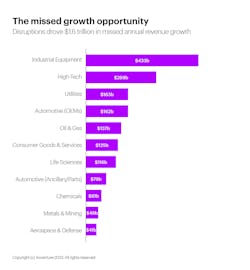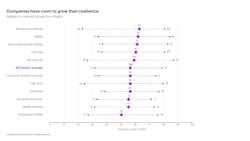Supply Chain Resiliency Can Be Boosted with Regional Production and Digital Maturity
Companies are ramping up regional suppliers and production facilities to become less vulnerable to disruption, according to Accenture’s “Resiliency in the making” research. By 2026, 65% of companies intend to buy most key items from regional suppliers, up from 38% today. Even more organizations (85%) plan to produce and sell most of their products in the same region by 2026, almost doubling from 43% today.
According to the report, regional sourcing and production are important to becoming less vulnerable to disruption, but not enough to reach sustained resiliency. Companies must also increase their digital maturity. They need to invest in data, AI and solutions like digital twins. Having more mature capabilities in these areas helps companies build reconfigurable supply chains and autonomous production. These capabilities also enable dynamic, sustainable product development and support decentralized, real-time decision-making at the frontlines of operations.
Disruptive events have surged in recent years, from geopolitical shifts and extreme weather to technology breakthroughs and material and talent shortages. Few businesses sustained their resilience and long-term growth amid the turbulence:
- In 2021 and 2022, companies missed out on $1.6 trillion in additional annual revenues because their engineering, supply, production or operations were disrupted.
- At the same time, the 25% most resilient companies achieved 3.6% higher annual revenues than the 25% most vulnerable companies.
Sef Tuma, global engineering and manufacturing lead, Accenture Industry X, said: “Resiliency has become an opportunity for growth, not just a strategy for survival. Taking advantage of this opportunity requires companies to drive the digitization of engineering, supply, production and operations processes. Solutions like digital twins and technologies like generative AI can help companies adapt faster to sudden changes and take data-driven, real-time actions.”
On average, companies are investing $1 billion in 2023 to digitize, automate and relocate supply and production facilities, which is expected to increase to at least $2.5 billion in 2026, according to the report.
Sunita Suryanarayan, global supply chain and operations resiliency lead at Accenture, commented: “When disruption struck, many companies quickly applied short-term fixes to their complex global production and supply networks. These networks had been designed for cost efficiency and just-in-time deliveries. Now is the time to strategically redesign them for multi-sourcing, without creating unwieldy silos or new bottlenecks, and make them more transparent and agile with data and AI to drive sustained resiliency.”
Sustained resiliency is still a distant prospect for many companies. As part of the research, Accenture developed a model to measure engineering, supply, production and operations resiliency on a 0-100 scale. On average, companies achieved a score of only 56.
The report recommends three areas companies should focus on to increase their resiliency:
- Visibility -- Companies should make supply chains and production processes more predictable and autonomous. For example, smart end-to-end control towers monitor processes and analyze different scenarios in real time to detect and correct issues early on. Today, only 11% have near real-time alerting; 78% need at least a week to fully understand the impact.
- Resiliency in design-- Moving activities earlier in the development process allows companies to get products, processes and ways of working right the first time. For example, digital twins – digital replicas of physical production facilities down to individual assembly lines and machines – allow product designers and engineers to identify and troubleshoot potential prototype issues or defects and iterate the design before production begins.
- New ways of working-- Businesses must upskill the workforce in data, AI and other digital technologies so they can use predictive and visualization tools to make data-driven decisions at the frontlines of business. Today, only 17% of companies already have such a multi-skilled, digitally literate workforce; 68% plan to have one by 2026.





